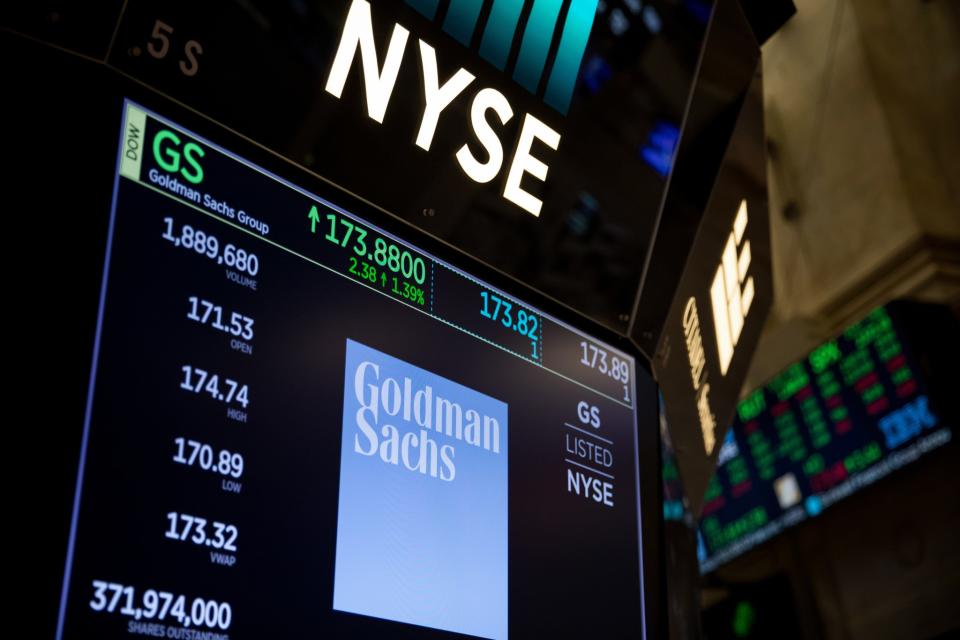Goldman Sachs was the ‘worst hit’ in the Fed’s latest stress test of big banks. Bank of America still lists it as a buy

The Federal Reserve on Wednesday released the results of its annual stress test to see how America’s 31 largest banks would fare in a financial crisis. While the hypothetical recession showed that all banks were well protected against an actual recession, they fared worse on average than in last year’s test.
According to a Bank of America report out Thursday, the “worst hit” was Goldman Sachs, with a year-over-year increase of roughly 100 basis points in its stress capital buffer. Bank of America’s analysts said this implies Goldman is exceeding the minimum requirement for globally important banks by approximately 60 basis points, meaning the firm has less excess capital compared with similarly sized peers. Columbus-based Huntington Bank and New York–based Citigroup were among the best-performing.
Goldman shares were down about 2% to roughly $447 at 1:30 p.m. ET, but so far this year the investment bank's stock has been on a tear, up more than 15%.
According to Bank of America, Goldman's earnings per share are expected to decrease by 3% as a result of slower than expected buybacks. But more optimistically, a near-term negative for Bank of America’s bullish investment thesis is partly underpinned by potential for an improving baseline going forward.
“Despite this negative which is not thesis-changing, we remain constructive on the stock,” the analysts write. They maintain the stock as a buy with a price objective of $525. Downside risks include a potentially weaker economy and geopolitical issues, with upside risks including stronger capital markets activity.
An Oppenheimer analyst also still has Goldman listed as a buy, with a target of $517, while a Morningstar analyst prefers a hold recommendation with a $417 target price, according to S&P Capital IQ data. Fortune reached out to both analysts for additional details but didn't hear back at time of publication.
According to a Federal Reserve statement, all 31 banks tested, including Bank of America, JPMorgan Chase, and Morgan Stanley, absorbed total projected hypothetical losses of $685 billion and remained above the minimum capital requirements for common equity tier 1 (CET1) banks, or banks considered important to the global economy. Under stress, the aggregate CET1 capital ratio—which cushions against losses—is projected to decline from 12.7% to 9.9%. Though this is a greater loss than last year, the Fed says it’s still within the range of recent tests.
It's perhaps a bit unnerving to see so many banks perform worse than a year ago, especially given a recent Wall Street Journal report that many of them were advocating to reduce capital requirements that currently start at 4.5% and increase based on bank size and performance during stress tests. According to the Journal, Goldman spent "millions" on an advocacy campaign, and the Financial Services Forum that represents the eight largest U.S. banks asked each of its members to contribute $2 million to another campaign.
The conditions of this year’s test for a “severe” global recession included a 40% decline in commercial real estate prices, a substantial increase in office vacancies, and a 36% decline in house prices. The unemployment rate for the test rose nearly 6.5 percentage points to a peak of 10%, and economic output plummeted.
"This year's stress test shows that large banks have sufficient capital to withstand a highly stressful scenario and meet their minimum capital ratios," vice chair for supervision Michael Barr said in a statement. "While the severity of this year's stress test is similar to last year's, the test resulted in higher losses because bank balance sheets are somewhat riskier and expenses are higher.”
This story was originally featured on Fortune.com

 Yahoo Finance
Yahoo Finance 